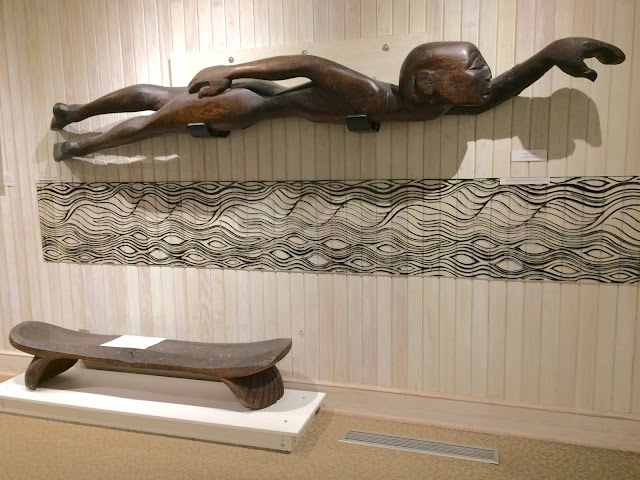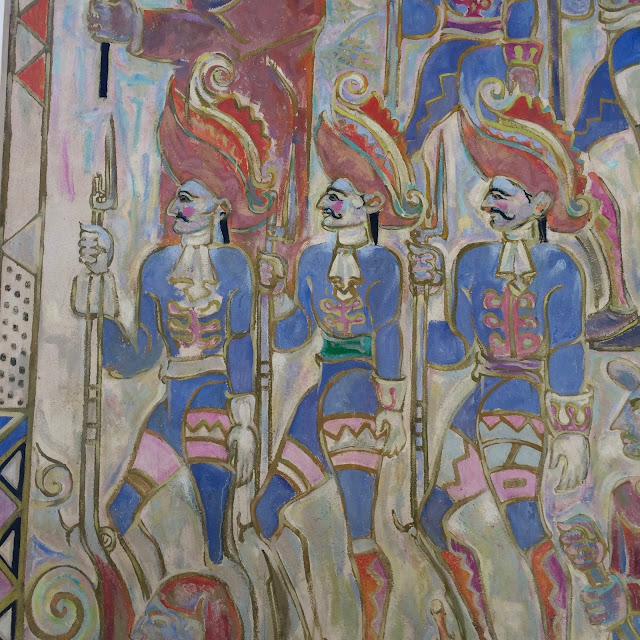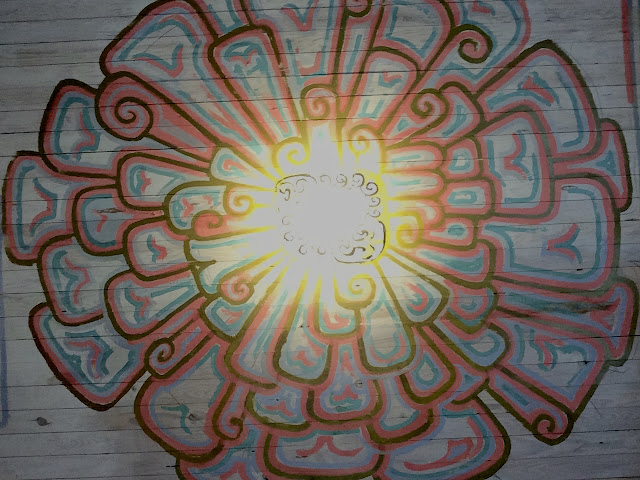February 1, 2017
One of the places that I want to paddle to is Horn Island, a barrier island off the coast of Mississippi., near Ocean Springs. It's been on my bucket list since the 1980's and Hulin and other paddling have told me stories about their trips out there. Hulin also told me stories of a reclusive artist who spent several years mostly living there. He would load up his rowboat and then row the eight miles to the island, sometimes at night. He left his wife to mostly raise their four children, and ended up painting thousands of paintings and doing some huge murals.
Hulin and I decided to visit his museum located next to the Community Center in Ocean Springs, Mississippi. The drive took almost two hours, including having to sit and wait for a wreck to be cleared.
We walked up to the Community Center first because Hulin remembered the entire walls were covered with Walter Anderson's paintings. The doors were locked but were of glass and I was in awe. We continued on to the museum and found we could visit the murals through the back of the museum. After watching an interesting video about the life of Walter Anderson, we explored the museum.
We started with the video. The next pictures are all from that room.
The next set of pictures are from the community center, the walls of which are completely covered with paintings. I could have spent more time here but Hulin was finished with the museum before I got my fill of this one room.
These two drawings were in the hall behind the gift shop.
I found some surprising crafts and art in addition to Walter Anderson's drawings and paintings, both in oil, during the early years and watercolor during his later years, except for his murals which were in oil. Both his older and younger brothers were also artists and craftsmen. The eldest, Peter was a highly admired potter. Walter and his younger brother were also associated with Shearwater Pottery. Walter did a lot of the painting on the pots and worked there throughout his life.
One room was devoted to the youngest brother, Mac Anderson.
From 1938-40, Walter spent most of his time in psychiatric hospitals. After that, he became something of the town bum, riding his old bicycle around and spending more and more time on Horn Island. He moved from his family to Shearwater cottage. After his death, is family found a locked room. Inside the walls and ceiling were completely covered with murals. That room was brought to the museum and added on. Following are some of the things that stood out.
We finished the trip by going to Realizations, the Walter Anderson shop, where Hulin bought a T-shirt. I loved the Pelican standing at the door to the shop.
I wondered if Shearwater Pottery was still a viable business. I looked it up when I came home and found we could have visited the showroom. Three of Peter Anderson's four children are still active in making pottery. The next time I'm over this way, I'd love to visit their showroom.
One of the places that I want to paddle to is Horn Island, a barrier island off the coast of Mississippi., near Ocean Springs. It's been on my bucket list since the 1980's and Hulin and other paddling have told me stories about their trips out there. Hulin also told me stories of a reclusive artist who spent several years mostly living there. He would load up his rowboat and then row the eight miles to the island, sometimes at night. He left his wife to mostly raise their four children, and ended up painting thousands of paintings and doing some huge murals.
Hulin and I decided to visit his museum located next to the Community Center in Ocean Springs, Mississippi. The drive took almost two hours, including having to sit and wait for a wreck to be cleared.
We walked up to the Community Center first because Hulin remembered the entire walls were covered with Walter Anderson's paintings. The doors were locked but were of glass and I was in awe. We continued on to the museum and found we could visit the murals through the back of the museum. After watching an interesting video about the life of Walter Anderson, we explored the museum.
 |
| The sign in front of the museum |
We started with the video. The next pictures are all from that room.
 |
| This display was in the room in which we watched the video |
 |
| I fell in love with these crabs |
 |
| The information said this was a painting of goldenrod |
 |
| This alligator gar reminded me of the many times I've hit one with a paddle - it's very disconcerting to do it at night and feel that you have hit a soft telephone pole that rolls |
The next set of pictures are from the community center, the walls of which are completely covered with paintings. I could have spent more time here but Hulin was finished with the museum before I got my fill of this one room.
 |
| The view of the front of the room |
 |
| There were many different subjects, and I didn't figure out why - but I like the nature based ones best |
 |
| I loved finding the wild animals in the murals |
 |
| I loved this repetitive pattern of many of his paintings |
 |
| Another fun find in the murals - a group of terns |
 |
| Some of the animals were more stylized than others |
 |
| The paintings disguised two doors |
These two drawings were in the hall behind the gift shop.
 |
| I loved this for it's simplicity and movement |
 |
| This was the only tessellation I saw |
 |
| This was unique in that it was the only portrait |
I found some surprising crafts and art in addition to Walter Anderson's drawings and paintings, both in oil, during the early years and watercolor during his later years, except for his murals which were in oil. Both his older and younger brothers were also artists and craftsmen. The eldest, Peter was a highly admired potter. Walter and his younger brother were also associated with Shearwater Pottery. Walter did a lot of the painting on the pots and worked there throughout his life.
One room was devoted to the youngest brother, Mac Anderson.
 |
| Oyster Tongers |
 |
| Coots on the Bayou - this feels like places I've paddled from Texas to North Carolina |
 |
| Black Skimmer |
 |
| Little green heron fishing |
 |
| The pottery figures were amazing |
 |
| These two small cow figures had great detailing |
 |
| A decorated cat with personality |
 |
| And one with a very different personality |
 |
| Some of the older brother, Peter's work |
 |
| Peter shook this after bringing it out of the kiln to make the curves |
There were several pieces of furniture in the display.
 |
| I loved the birds worked into the legs of this table |
 |
| And this chair looked so comfortable and stylish |
From 1938-40, Walter spent most of his time in psychiatric hospitals. After that, he became something of the town bum, riding his old bicycle around and spending more and more time on Horn Island. He moved from his family to Shearwater cottage. After his death, is family found a locked room. Inside the walls and ceiling were completely covered with murals. That room was brought to the museum and added on. Following are some of the things that stood out.
 |
| Such a pretty possum |
 |
| The light was surrounded by this painting |
 |
| I was amazed at the vibrancy of the paintings - he used the leftover paint from painting the murals in the Community Center |
 |
| Skimmers |
We finished the trip by going to Realizations, the Walter Anderson shop, where Hulin bought a T-shirt. I loved the Pelican standing at the door to the shop.
 |
| The shop pelican looking ready for Mardi Gras - decorations are already up in many places - it will happen on February 28 |
I wondered if Shearwater Pottery was still a viable business. I looked it up when I came home and found we could have visited the showroom. Three of Peter Anderson's four children are still active in making pottery. The next time I'm over this way, I'd love to visit their showroom.

No comments:
Post a Comment